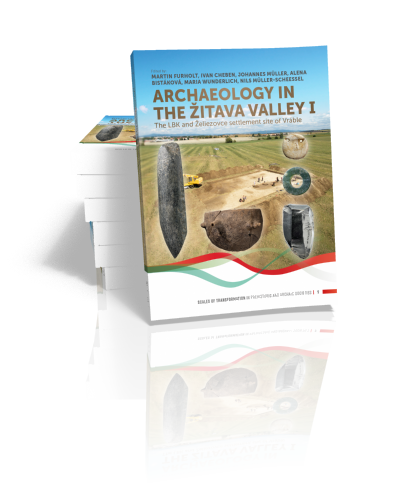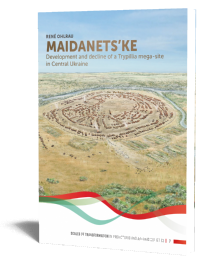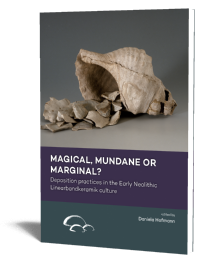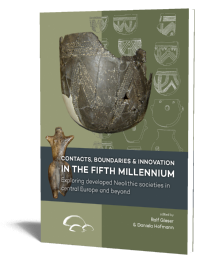Archaeology in the Žitava valley I
The LBK and Želiezovce settlement site of Vráble
Edited by Martin Furholt, Ivan Cheben, Johannes Müller, Alena Bistáková, Maria Wunderlich & Nils Müller-Scheeßel | 2020

Archaeology in the Žitava valley I
The LBK and Želiezovce settlement site of Vráble
Edited by Martin Furholt, Ivan Cheben, Johannes Müller, Alena Bistáková, Maria Wunderlich & Nils Müller-Scheeßel | 2020
Paperback ISBN: 9789088908972 | Hardback ISBN: 9789088908989 | Imprint: Sidestone Press Academics | Format: 210x280mm | 546 pp. | Scales of Transformation 09 | Series: Scales of Transformation | Language: English | 50 illus. (bw) | 157 illus. (fc) | Keywords: European Early Neolithic; LBK, settlement patterns; social organization; social conflict; village and neighbourhood structures; burial rites; enclosure; excavation report | download cover | DOI: 10.59641/j2790mv
Read online or downloaded 1806 times
-
Digital & Online access
This is a full Open Access publication, click below to buy in print, browse, or download for free.
-
Buy via Sidestone (EU & UK)
-
Buy via our Distributors (WORLD)
For non-EU or UK destinations you can buy our books via our international distributors. Although prices may vary this will ensure speedy delivery and reduction in shipping costs or import tax. But you can also order with us directly via the module above.
UK international distributor
USA international distributor
-
Bookinfo
Paperback ISBN: 9789088908972 | Hardback ISBN: 9789088908989 | Imprint: Sidestone Press Academics | Format: 210x280mm | 546 pp. | Scales of Transformation 09 | Series: Scales of Transformation | Language: English | 50 illus. (bw) | 157 illus. (fc) | Keywords: European Early Neolithic; LBK, settlement patterns; social organization; social conflict; village and neighbourhood structures; burial rites; enclosure; excavation report | download cover | DOI: 10.59641/j2790mv
Read online or downloaded 1806 times

We will plant a tree for each order containing a paperback or hardback book via OneTreePlanted.org.
The early Neolithic site of Vráble (5250-4950 cal BCE) is among the largest LBK settlement agglomerations in Central Europe, and exceptional within the southwest Slovakian area. Geophysical surveys revealed more than 300 houses, grouped into three contemporary neighbourhoods, one of which is delineated by a complex ditched enclosure system. This enclosure is associated with a large number of human remains, which reveal new patterns of burial and deposition practices. This volume presents the first part of the results of an international research project that was started in 2012 and aims to explore the social implications of settlement concentration in the context of early farming communities, on the background of subsistence patterns and landscape use.
This is the first volume of “Archaeology in the Žitava valley”, and it presents the finds, features and data uncovered and synthesised from our archaeological, pedological, geophysical, archaeobotanical, anthropological, zoo-archaeological and stable isotope studies on the site of Vráble “Veľké Lehemby” and “Fárske” in southwest Slovakia. These data are used to reconstruct the social and economic patterns and social processes, highlighting a growing tension between incentives of cooperation and sharing vs. monopolisation of resources and individual interests, driving the 300-year history of this site until its total abandonment. While the history of Vráble is unique, it holds clues for a better understanding of the overall, central European phenomenon of large, enclosed settlements of the later LBK, their association with rituals and violence involving human bodies, and the end of the LBK social world.
1. Research at the LBK and Želiezovce settlement site of Vráble
Ivan Cheben, Martin Furholt
2. Scientific analyses at Vráble
2.1 Large scale magnetic prospections at Vráble “Veľké Lehemby” and “Fárske”
Knut Rassmann, Kay Winkelmann, Wolfgang Rabbel, Martin Furholt
2.2 Extending archaeological documentation from 2D to 3D: The benefits of geophysical on-site measurements in excavations
Natalie Pickartz, Erica Corradini, Raphael Kahn, Diana Panning, Knut Rassmann, Nils Müller-Scheeßel, Martin Furholt, Dennis Wilken, Tina Wunderlich, Wolfgang Rabbel
2.3 Geoarchaeology at Neolithic Vráble, Slovakia – New insights into early environmental impact from soils and sediments
Stefan Dreibrodt, Hans-Rudolf Bork
3. Settlement features and human burials
3.1. Built structures at the LBK and Želiezovce settlement site of Vráble
Ivan Cheben, Martin Furholt, Nils Müller-Scheeßel
3.2. The burials and human remains from the LBK and Želiezovce settlement site of Vráble
Nils Müller-Scheeßel, Zuzana Hukeľová
4. Chronology
4.1. Typochronology of the pottery from the LBK and Želiezovce settlement site of Vráble
Ivan Cheben, Alena Bistakova, Martin Furholt, Bastian Wolthoff, Wiebke Mainusch, Nils Müller-Scheeßel
4.2 Radiocarbon dating at the LBK and Želiezovce settlement site of Vráble
John Meadows
5. Material Culture, plants and animal data
5.1 The pottery and ornamentic styles from the LBK and Želiezovce settlement site of Vráble
Ivan, Cheben, Alena Bistakova
5.2 Stone tools from the LBK and Želiezovce settlement site of Vráble
Michael Cheben, Nils Müller-Scheeßel
5.3 Bone tools from the LBK and Želiezovce settlement site of Vráble
Rebekka Eckelmann
5.4 Animal bones from the LBK and Želiezovce settlement site of Vráble
Ulrich Schmölcke, Rebekka Eckelmann
5.5 Archaeobotanical remains from the LBK and Želiezovce settlement site of Vráble
Dragana Filipović, Helmut Kroll, Wiebke Kirleis
5.6 Anthracological remains from the LBK and Želiezovce settlement site of Vráble
Tim Schroedter
5.7 Snail Shells from the LBK and Želiezovce settlement site of Vráble
Frank Schlütz
5.8 Stable isotopic perspectives of animal and human diet at the LBK and Želiezovce settlement site of Vráble
Rosalind E. Gillis, Cheryl A. Makarewicz
6. Synthesis: Demography, economy and social organisation at the LBK and Želiezovce settlement site of Vráble
6.1 Demography of the LBK and Želiezovce settlement site of Vráble and the Žitava valley
Johannes Müller, Maria Wunderlich, Ivan Cheben, Alena Bistakova, Nils Müller-Scheeßel, Martin Furholt
6.2 Subsistence economy of the LBK and Želiezovce settlement site of Vráble
Martin Furholt, Dragana Filipović, Ulrich Schmölcke, Rebekka Eckelmann
6.3 A political economy of the LBK and Želiezovce settlement site of Vráble
Maria Wunderlich, Martin Furholt, Johannes Müller, Ivan Cheben, Alena Bistakova, Nils Müller-Scheeßel

Prof. dr. Johannes Müller
Johannes Müller (PhD, University of Freiburg, 1990) is a Professor and Director of the Institute for Prehistoric and Protohistoric Archaeology at Kiel University, Germany. He is the founding director of the Johanna Mestorf Academy, Speaker of the Collaborative Research Centre “Scales of Transformation: Human-environmental Interaction in Prehistoric and Archaic Societies”and of the Excellence Cluster “ROOTS – Social, Environmental, and Cultural Connectivity in Past Societies”.

Prof. Dr. Martin Furholt
Martin Furholt is Professor of Social Archaeology at Kiel University. His main research interests are the political dimension of social organisation in the past, and prehistoric mobility during the Neolithic and Bronze Age periods in Europe. He is currently conducting fieldwork on 6th and 5th millennium BCE Neolithic settlement in Slovakia and Serbia, and publishes papers related to the ongoing 3rd millennium migration debate in Europe.
Alena Bistáková
Alena Bistáková is Researcher at the Archaeological Institute of the Slovak Academy of Sciences in Nitra. Her main interests are material culture studies, settlement structures and burial rite of Neolithic and Copper Age periods in Central Europe. She has conducted archaeological fieldwork in Slovakia. She has worked on projects in Central Europe, covering the Neolithic to the Bronze Age and archaeological practices and knowledge work in the digital environment. She is part of the Vráble project since 2018.
Ivan Cheben
Ivan Cheben is a Researcher at the Archaeological Institute of the Slovak Academy of Sciences in Nitra. His main research interests are material culture studies and settlement patterns of Neolithic and Copper Age periods in Central Europe. He has an extensive experience in archaeological fieldwork in Slovakia, and served as the head of rescue excavations in SW Slovakia for many years. Since 2012 he is head of the Vráble fieldwork project.
Nils Müller-Scheeßel
Nils Müller-Scheeßel is Scientific Editor and Lecturer at Kiel University. He has worked on several projects in central and south-eastern Europe, covering the Neolithic to the Iron Age, and joined the Vráble project in 2016. His particular interests include the means and meaning of the disposal of the dead, landscape archaeology, the possibilities of remote sensing, as well as quantitative methods.
Dr. Maria Wunderlich
Maria Wunderlich is currently a Lecturer and Research Fellow at the Institute of Pre-and Protohistoric Archaeology, Kiel University. For her PhD-studies between 2014 and 2018 she was involved in the DFG-project “Equality and Inequality: Social Differentiation in Northern Central Europe 4300-2400 BC” as a research assistant. For her comparative thesis on “Megalithic monuments and social structures” she conducted ethnoarchaeological field work in Sumba, Indonesia, and Nagaland, North-East India. Being interested in social archaeology and comparative analyses, she combines different theoretical approaches with material data derived both in recent and archaeological contexts.
Abstract:
The early Neolithic site of Vráble (5250-4950 cal BCE) is among the largest LBK settlement agglomerations in Central Europe, and exceptional within the southwest Slovakian area. Geophysical surveys revealed more than 300 houses, grouped into three contemporary neighbourhoods, one of which is delineated by a complex ditched enclosure system. This enclosure is associated with a large number of human remains, which reveal new patterns of burial and deposition practices. This volume presents the first part of the results of an international research project that was started in 2012 and aims to explore the social implications of settlement concentration in the context of early farming communities, on the background of subsistence patterns and landscape use.
This is the first volume of “Archaeology in the Žitava valley”, and it presents the finds, features and data uncovered and synthesised from our archaeological, pedological, geophysical, archaeobotanical, anthropological, zoo-archaeological and stable isotope studies on the site of Vráble “Veľké Lehemby” and “Fárske” in southwest Slovakia. These data are used to reconstruct the social and economic patterns and social processes, highlighting a growing tension between incentives of cooperation and sharing vs. monopolisation of resources and individual interests, driving the 300-year history of this site until its total abandonment. While the history of Vráble is unique, it holds clues for a better understanding of the overall, central European phenomenon of large, enclosed settlements of the later LBK, their association with rituals and violence involving human bodies, and the end of the LBK social world.
Contents
1. Research at the LBK and Želiezovce settlement site of Vráble
Ivan Cheben, Martin Furholt
2. Scientific analyses at Vráble
2.1 Large scale magnetic prospections at Vráble “Veľké Lehemby” and “Fárske”
Knut Rassmann, Kay Winkelmann, Wolfgang Rabbel, Martin Furholt
2.2 Extending archaeological documentation from 2D to 3D: The benefits of geophysical on-site measurements in excavations
Natalie Pickartz, Erica Corradini, Raphael Kahn, Diana Panning, Knut Rassmann, Nils Müller-Scheeßel, Martin Furholt, Dennis Wilken, Tina Wunderlich, Wolfgang Rabbel
2.3 Geoarchaeology at Neolithic Vráble, Slovakia – New insights into early environmental impact from soils and sediments
Stefan Dreibrodt, Hans-Rudolf Bork
3. Settlement features and human burials
3.1. Built structures at the LBK and Želiezovce settlement site of Vráble
Ivan Cheben, Martin Furholt, Nils Müller-Scheeßel
3.2. The burials and human remains from the LBK and Želiezovce settlement site of Vráble
Nils Müller-Scheeßel, Zuzana Hukeľová
4. Chronology
4.1. Typochronology of the pottery from the LBK and Želiezovce settlement site of Vráble
Ivan Cheben, Alena Bistakova, Martin Furholt, Bastian Wolthoff, Wiebke Mainusch, Nils Müller-Scheeßel
4.2 Radiocarbon dating at the LBK and Želiezovce settlement site of Vráble
John Meadows
5. Material Culture, plants and animal data
5.1 The pottery and ornamentic styles from the LBK and Želiezovce settlement site of Vráble
Ivan, Cheben, Alena Bistakova
5.2 Stone tools from the LBK and Želiezovce settlement site of Vráble
Michael Cheben, Nils Müller-Scheeßel
5.3 Bone tools from the LBK and Želiezovce settlement site of Vráble
Rebekka Eckelmann
5.4 Animal bones from the LBK and Želiezovce settlement site of Vráble
Ulrich Schmölcke, Rebekka Eckelmann
5.5 Archaeobotanical remains from the LBK and Želiezovce settlement site of Vráble
Dragana Filipović, Helmut Kroll, Wiebke Kirleis
5.6 Anthracological remains from the LBK and Želiezovce settlement site of Vráble
Tim Schroedter
5.7 Snail Shells from the LBK and Želiezovce settlement site of Vráble
Frank Schlütz
5.8 Stable isotopic perspectives of animal and human diet at the LBK and Želiezovce settlement site of Vráble
Rosalind E. Gillis, Cheryl A. Makarewicz
6. Synthesis: Demography, economy and social organisation at the LBK and Želiezovce settlement site of Vráble
6.1 Demography of the LBK and Želiezovce settlement site of Vráble and the Žitava valley
Johannes Müller, Maria Wunderlich, Ivan Cheben, Alena Bistakova, Nils Müller-Scheeßel, Martin Furholt
6.2 Subsistence economy of the LBK and Želiezovce settlement site of Vráble
Martin Furholt, Dragana Filipović, Ulrich Schmölcke, Rebekka Eckelmann
6.3 A political economy of the LBK and Želiezovce settlement site of Vráble
Maria Wunderlich, Martin Furholt, Johannes Müller, Ivan Cheben, Alena Bistakova, Nils Müller-Scheeßel

Prof. dr. Johannes Müller
Johannes Müller (PhD, University of Freiburg, 1990) is a Professor and Director of the Institute for Prehistoric and Protohistoric Archaeology at Kiel University, Germany. He is the founding director of the Johanna Mestorf Academy, Speaker of the Collaborative Research Centre “Scales of Transformation: Human-environmental Interaction in Prehistoric and Archaic Societies”and of the Excellence Cluster “ROOTS – Social, Environmental, and Cultural Connectivity in Past Societies”.

Prof. Dr. Martin Furholt
Martin Furholt is Professor of Social Archaeology at Kiel University. His main research interests are the political dimension of social organisation in the past, and prehistoric mobility during the Neolithic and Bronze Age periods in Europe. He is currently conducting fieldwork on 6th and 5th millennium BCE Neolithic settlement in Slovakia and Serbia, and publishes papers related to the ongoing 3rd millennium migration debate in Europe.
Alena Bistáková
Alena Bistáková is Researcher at the Archaeological Institute of the Slovak Academy of Sciences in Nitra. Her main interests are material culture studies, settlement structures and burial rite of Neolithic and Copper Age periods in Central Europe. She has conducted archaeological fieldwork in Slovakia. She has worked on projects in Central Europe, covering the Neolithic to the Bronze Age and archaeological practices and knowledge work in the digital environment. She is part of the Vráble project since 2018.
Ivan Cheben
Ivan Cheben is a Researcher at the Archaeological Institute of the Slovak Academy of Sciences in Nitra. His main research interests are material culture studies and settlement patterns of Neolithic and Copper Age periods in Central Europe. He has an extensive experience in archaeological fieldwork in Slovakia, and served as the head of rescue excavations in SW Slovakia for many years. Since 2012 he is head of the Vráble fieldwork project.
Nils Müller-Scheeßel
Nils Müller-Scheeßel is Scientific Editor and Lecturer at Kiel University. He has worked on several projects in central and south-eastern Europe, covering the Neolithic to the Iron Age, and joined the Vráble project in 2016. His particular interests include the means and meaning of the disposal of the dead, landscape archaeology, the possibilities of remote sensing, as well as quantitative methods.
Dr. Maria Wunderlich
Maria Wunderlich is currently a Lecturer and Research Fellow at the Institute of Pre-and Protohistoric Archaeology, Kiel University. For her PhD-studies between 2014 and 2018 she was involved in the DFG-project “Equality and Inequality: Social Differentiation in Northern Central Europe 4300-2400 BC” as a research assistant. For her comparative thesis on “Megalithic monuments and social structures” she conducted ethnoarchaeological field work in Sumba, Indonesia, and Nagaland, North-East India. Being interested in social archaeology and comparative analyses, she combines different theoretical approaches with material data derived both in recent and archaeological contexts.
-
Digital & Online access
This is a full Open Access publication, click below to buy in print, browse, or download for free.
-
Buy via Sidestone (EU & UK)
-
Buy via our Distributors (WORLD)
For non-EU or UK destinations you can buy our books via our international distributors. Although prices may vary this will ensure speedy delivery and reduction in shipping costs or import tax. But you can also order with us directly via the module above.
UK international distributor
USA international distributor
- Browse all books by subject
-
Search all books

We will plant a tree for each order containing a paperback or hardback book via OneTreePlanted.org.
You might also like:
© 2026 Sidestone Press KvK nr. 28114891 Privacy policy Sidestone Newsletter Terms and Conditions (Dutch)








